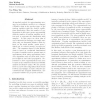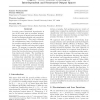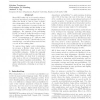ICML
2004
IEEE
15 years 15 days ago
2004
IEEE
Classifier learning methods commonly assume that the training data consist of randomly drawn examples from the same distribution as the test examples about which the learned model...
ICML
2004
IEEE
15 years 15 days ago
2004
IEEE
ICML
2004
IEEE
15 years 15 days ago
2004
IEEE
This paper addresses the problem of constructing good action selection policies for agents acting in partially observable environments, a class of problems generally known as Part...
ICML
2004
IEEE
15 years 15 days ago
2004
IEEE
A standard method for approximating averages in probabilistic models is to construct a Markov chain in the product space of the random variables with the desired equilibrium distr...
ICML
2004
IEEE
15 years 15 days ago
2004
IEEE
We introduce a framework, which we call Divide-by-2 (DB2), for extending support vector machines (SVM) to multi-class problems. DB2 offers an alternative to the standard one-again...
ICML
2004
IEEE
15 years 15 days ago
2004
IEEE
Learning general functional dependencies is one of the main goals in machine learning. Recent progress in kernel-based methods has focused on designing flexible and powerful input...
ICML
2004
IEEE
15 years 15 days ago
2004
IEEE
Many NLP tasks rely on accurately estimating word dependency probabilities P(w1|w2), where the words w1 and w2 have a particular relationship (such as verb-object). Because of the...
ICML
2004
IEEE
15 years 15 days ago
2004
IEEE
Markov networks are extensively used to model complex sequential, spatial, and relational interactions in fields as diverse as image processing, natural language analysis, and bio...
ICML
2004
IEEE
15 years 15 days ago
2004
IEEE
The multiple-instance learning (MIL) model has been very successful in application areas such as drug discovery and content-based imageretrieval. Recently, a generalization of thi...
ICML
2004
IEEE
15 years 15 days ago
2004
IEEE



